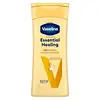Vaseline Intensive Care Cocoa Radiant Vitalizing Body Oil Versus Vaseline Intensive Care Essential Healing Body Lotion
What's inside
What's inside
 Key Ingredients
Key Ingredients

No key ingredients
 Benefits
Benefits

No benefits
 Concerns
Concerns

 Ingredients Side-by-side
Ingredients Side-by-side

Water
Skin ConditioningGlycerin
HumectantStearic Acid
CleansingPalmitic Acid
EmollientIsopropyl Myristate
EmollientParaffinum Liquidum
EmollientPetrolatum
EmollientAvena Sativa Straw Extract
Skin ConditioningDimethicone
EmollientDihydroxypropyltrimonium Chloride
HumectantHydroxyethyl Urea
HumectantPropylene Glycol
HumectantLactic Acid
BufferingGlyceryl Stearate
EmollientGlycol Stearate
EmollientPEG-100 Stearate
Cetyl Alcohol
EmollientStearamide Amp
Sodium Hydroxide
BufferingTapioca Starch
Magnesium Aluminum Silicate
AbsorbentAcrylates/C10-30 Alkyl Acrylate Crosspolymer
Emulsion StabilisingXanthan Gum
EmulsifyingDisodium EDTA
Parfum
MaskingMethylparaben
PreservativePhenoxyethanol
PreservativePropylparaben
PreservativeAlpha-Isomethyl Ionone
PerfumingAmyl Cinnamal
PerfumingButylphenyl Methylpropional
PerfumingCitronellol
PerfumingCoumarin
PerfumingHexyl Cinnamal
PerfumingGeraniol
PerfumingBenzyl Alcohol
PerfumingLimonene
PerfumingLinalool
PerfumingWater, Glycerin, Stearic Acid, Palmitic Acid, Isopropyl Myristate, Paraffinum Liquidum, Petrolatum, Avena Sativa Straw Extract, Dimethicone, Dihydroxypropyltrimonium Chloride, Hydroxyethyl Urea, Propylene Glycol, Lactic Acid, Glyceryl Stearate, Glycol Stearate, PEG-100 Stearate, Cetyl Alcohol, Stearamide Amp, Sodium Hydroxide, Tapioca Starch, Magnesium Aluminum Silicate, Acrylates/C10-30 Alkyl Acrylate Crosspolymer, Xanthan Gum, Disodium EDTA, Parfum, Methylparaben, Phenoxyethanol, Propylparaben, Alpha-Isomethyl Ionone, Amyl Cinnamal, Butylphenyl Methylpropional, Citronellol, Coumarin, Hexyl Cinnamal, Geraniol, Benzyl Alcohol, Limonene, Linalool
Ingredients Explained
These ingredients are found in both products.
Ingredients higher up in an ingredient list are typically present in a larger amount.
Coumarins are a group of substances found naturally in plants. There are over 1300 types of coumarins identified. It has a natural vanilla scent.
Coumarin is an identified EU known allergy, meaning it may cause an allergic reaction when applied to the skin.
In many countries, coumarin is banned as a food additive. However, it can be found in soaps, tobacco products, and some alcohol drinks.
Plants use coumarins as a chemical defense. Some plants that have coumarins include lavender, tonka beans, and yellow clovers.
Learn more about CoumarinGeraniol is used to add fragrance/parfum to a product. It is the main component of citronellol. It is a monoterpenoid and an alcohol.
Monoterpenes are naturally found in many parts of different plants.
Geraniol can be found in many essential oils including Rose Oil and Citronella Oil. The scent of Geraniol is often described as "rose-like". Many foods also contain Geraniol for fruit flavoring.
Geraniol can irritate the skin when exposed to air. However, irritation depends on the ability of geraniol to penetrate into the skin. In general, geraniol is not able to penetrate skin easily.
Geraniol is colorless and has low water-solubility. However, it is soluble in common organic solvents.
Like citronellol, it is a natural insect repellent.
2,6-Octadien-1-ol, 3,7-dimethyl-, (2E)-
Learn more about GeraniolHexyl Cinnamal is a fragrance ingredient with a similar scent to jasmine. It can be naturally found in chamomile essential oil.
This ingredient is a known EU allergen and may sensitize the skin. The EU requires this ingredient to be listed separately on an ingredients list.
Hexyl Cinnamal is not water soluble but is soluble in oils.
Learn more about Hexyl CinnamalLinalool is a fragrance and helps add scent to products. It's derived from common plants such as cinnamon, mint, citrus, and lavender.
Like Limonene, this ingredient oxidizes when exposed to air. Oxidized linalool can cause allergies and skin sensitivity.
This ingredient has a scent that is floral, spicy tropical, and citrus-like.
Learn more about LinaloolParaffinum Liquidum is also known as liquid paraffin. It is a type of highly refined mineral oil.
Like other oils, Paraffinum Liquidum has emollient properties. Emollients help soothe and soften the skin. By creating a barrier to trap moisture within, emollients help keep your skin hydrated.
Paraffinum Liquidum does not irritate the skin and is non-comedogenic.
Learn more about Paraffinum LiquidumParfum is a catch-all term for an ingredient or more that is used to give a scent to products.
Also called "fragrance", this ingredient can be a blend of hundreds of chemicals or plant oils. This means every product with "fragrance" or "parfum" in the ingredients list is a different mixture.
For instance, Habanolide is a proprietary trade name for a specific aroma chemical. When used as a fragrance ingredient in cosmetics, most aroma chemicals fall under the broad labeling category of “FRAGRANCE” or “PARFUM” according to EU and US regulations.
The term 'parfum' or 'fragrance' is not regulated in many countries. In many cases, it is up to the brand to define this term.
For instance, many brands choose to label themselves as "fragrance-free" because they are not using synthetic fragrances. However, their products may still contain ingredients such as essential oils that are considered a fragrance by INCI standards.
One example is Calendula flower extract. Calendula is an essential oil that still imparts a scent or 'fragrance'.
Depending on the blend, the ingredients in the mixture can cause allergies and sensitivities on the skin. Some ingredients that are known EU allergens include linalool and citronellol.
Parfum can also be used to mask or cover an unpleasant scent.
The bottom line is: not all fragrances/parfum/ingredients are created equally. If you are worried about fragrances, we recommend taking a closer look at an ingredient. And of course, we always recommend speaking with a professional.
Learn more about Parfum